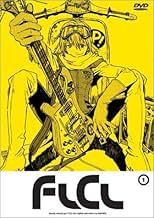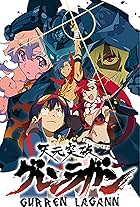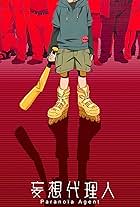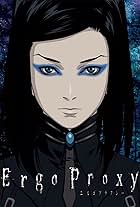Mysterious things start happening when 12-year-old Naota meets a strange woman on a Vespa wielding a big guitar.Mysterious things start happening when 12-year-old Naota meets a strange woman on a Vespa wielding a big guitar.Mysterious things start happening when 12-year-old Naota meets a strange woman on a Vespa wielding a big guitar.
- Awards
- 1 nomination
Browse episodes
Storyline
Did you know
- TriviaAmarao's eyebrows are actually sheets of "nori", dried seaweed that is used in sushi. The nori was digitally scanned into a computer.
- GoofsWhen there's a bird's eye view of the floor, 'medical mechanica' was misspelled 'medical meccanica.'
- Quotes
Naota: When you're in a town like this all covered with smoke, you forget that there's a world outside. Nothing amazing happens here. And you get used to that, used to a world where everything is ordinary. Every day we spend here is like a whole lifetime of dying slowly. But now Haruko is here. That's how I know there really is a world outside.
- Crazy creditsMiyu Miyu - ?
- Alternate versionsWhen screened on Cartoon Network's Adult Swim in the US, the ending credits are displayed in untranslated Japanese. The North American DVD however, released by Synch-Point, only has the ending credits translated in English.
- ConnectionsFeatured in AMV Hell 3: The Motion Picture (2005)
- SoundtracksRide on shooting star
Performed by the pillows
Lyrics and Music by Sawao Yamanaka
Arrangement by the pillows
Featured review
FLCL (short for "Furi Kuri", although I really have no clue how or why) is a highly stylized show. It's light-speed flow of dialog train-wrecks with the multitude of visual accompaniments in a strange combination of storytelling and all-out madness. There's no denying it, Furi Kuri will almost assuredly make you say "What the **** did I just watch?" I won't try to convince you of anything but that fact, nor do I feel anyone should. The show was made to warp minds while telling a tale - yes, there IS a plot underneath all this insanity - and cover as many genres, as many styles and subjects and tastes as possible. It is madcap entertainment, that's for sure.
Any attempts to cover the storyline for this series feel as if they'll ultimately end in failure, primarily because saying too much would spoil the plot...and you can't tread very far without toeing that line. Therefore, I'll make an attempt at telling what I can, trying not to spoil anything.
::takes a deep breath::
Naota is a sarcastic, smart-alec 12-year-old with a distaste for bitter drinks and sports a baseball bat at all times. He lives with his father and grandfather, and has a strange friendship with his older-brothers' girlfriend, Mamimi. Naota generally finds life boring in his town, a run-of-the-mill city with nothing out of the ordinary ever happening (despite the fact that there is a giant factory at the edge of town, a factory in the shape of a giant iron). This dull life changes when, for no apparent reason, a pink-haired girl named Haruko shows up on a moped...and proceeds to plow right into Naota, sending headlong into an adventure he would most likely prefer to avoid. With the entrance of Haruko into Naota's life, everything - not just his everyday life, but everything else around the entire city - seems to become even stranger and stranger. Naruko apparently has some strange obsession with Naota, one that requires the occasional beating with a guitar (aw, heck...she does that to everyone).
That's a fairly loose run-down of the series. However, the focus seems to be very, VERY far removed from such down-to-earth elements as "Following a steady plot" or "developing characters"; instead, Furi Kuri seems to lampoon anything and everything it can, from basic elements of life and society to American Television (yes, there is a South Park section in the series). It flows so quickly you feel as if you're being overwhelmed, yet at times the show appears to slow down, just enough to let the poor audience barely catch up...and then speed off again, taunting the viewers with its very appearance.
How can a show be so cruel in its simple execution? Imagine a fairly normal scene of Naota reminiscing about his older brother (whom has gone to America to play Baseball). Naota then proceeds to walk into his kitchen, discovering Haruko has appeared at his house. Without any warning the show shifts into hyperdrive, transforming into a moving manga (Japanese black-and-white comic), telling the next few scenes with crazed voice acting and rapid camera movement, mimicking a person reading such a publication. There are moments when the show will shift to cliched Anime moments (the "gun-fight" camera, with characters flying about and spraying bullets) back to normal time simply because it WANTS to. The show is driven by a madman, driving to make madmen of us all. ...and yet somehow the show is comprehensible after a few viewings, subtle moments once misunderstood now coming in clear(er). You get the feeling of several layers of meaning coming from all angles, several topics being touched upon, the show proving that it is more than just a crazy attempt at randomness in entertainment. The last episode, while lacking any true "tying up of loose ends" at least brings all events of the past to a pseudo-close, bringing an understanding to the basest wackiness exhibited.
Usually, I find myself enjoying shows that are able to combine elements into powerful scenes - Cowboy Bebop is a good example of this, splicing wonderful jazz and rock with the action pacing of each section of the series. Furi Kuri, however, throws this concept right out the window, apparently making the attempt at clashing anything and everything they can without wholly losing its sanity in the process. The music, performed by J-Pop (J-Rock?) group "The Pillows" has a rock/punk edge to it, yet feels easygoing and fun to listen to. This music almost seems out of place when taken in conjunction with the wild action and oddities that are viewed; large fights take place with simple guitar-riffs in the background, appearing as an attempt to downplay the action as nothing more than a childs' imagination.
One could probably get away with calling this show a visual representation of a childs' imagination, actually. It only has boundaries where it sees fit, it plays whatever music it wants to whenever it wants to, and it jumps from topic to topic as if it suffers from ADHD and has ingested a few bowls of sugar. The people may stay the same (for the most part), but everything else defies logic, reality, and reason. Despite its extremely varied existence, I enjoyed the series immensely, and suggest it to anyone who wants to experience...well, anything. It doesn't single out certain topics - like love, friendship, actions, self-depricating humor - instead opting to tackle them all and mush them together into 20-minutes of super-phrenic television. If you don't enjoy the absolute craziness of FLCL, then you should at least respect it for its ability to throw caution (and most everything else) to the wind and go with whatever it feels like doing. Hey, since when has 6 episodes of dementia been this fun?
Any attempts to cover the storyline for this series feel as if they'll ultimately end in failure, primarily because saying too much would spoil the plot...and you can't tread very far without toeing that line. Therefore, I'll make an attempt at telling what I can, trying not to spoil anything.
::takes a deep breath::
Naota is a sarcastic, smart-alec 12-year-old with a distaste for bitter drinks and sports a baseball bat at all times. He lives with his father and grandfather, and has a strange friendship with his older-brothers' girlfriend, Mamimi. Naota generally finds life boring in his town, a run-of-the-mill city with nothing out of the ordinary ever happening (despite the fact that there is a giant factory at the edge of town, a factory in the shape of a giant iron). This dull life changes when, for no apparent reason, a pink-haired girl named Haruko shows up on a moped...and proceeds to plow right into Naota, sending headlong into an adventure he would most likely prefer to avoid. With the entrance of Haruko into Naota's life, everything - not just his everyday life, but everything else around the entire city - seems to become even stranger and stranger. Naruko apparently has some strange obsession with Naota, one that requires the occasional beating with a guitar (aw, heck...she does that to everyone).
That's a fairly loose run-down of the series. However, the focus seems to be very, VERY far removed from such down-to-earth elements as "Following a steady plot" or "developing characters"; instead, Furi Kuri seems to lampoon anything and everything it can, from basic elements of life and society to American Television (yes, there is a South Park section in the series). It flows so quickly you feel as if you're being overwhelmed, yet at times the show appears to slow down, just enough to let the poor audience barely catch up...and then speed off again, taunting the viewers with its very appearance.
How can a show be so cruel in its simple execution? Imagine a fairly normal scene of Naota reminiscing about his older brother (whom has gone to America to play Baseball). Naota then proceeds to walk into his kitchen, discovering Haruko has appeared at his house. Without any warning the show shifts into hyperdrive, transforming into a moving manga (Japanese black-and-white comic), telling the next few scenes with crazed voice acting and rapid camera movement, mimicking a person reading such a publication. There are moments when the show will shift to cliched Anime moments (the "gun-fight" camera, with characters flying about and spraying bullets) back to normal time simply because it WANTS to. The show is driven by a madman, driving to make madmen of us all. ...and yet somehow the show is comprehensible after a few viewings, subtle moments once misunderstood now coming in clear(er). You get the feeling of several layers of meaning coming from all angles, several topics being touched upon, the show proving that it is more than just a crazy attempt at randomness in entertainment. The last episode, while lacking any true "tying up of loose ends" at least brings all events of the past to a pseudo-close, bringing an understanding to the basest wackiness exhibited.
Usually, I find myself enjoying shows that are able to combine elements into powerful scenes - Cowboy Bebop is a good example of this, splicing wonderful jazz and rock with the action pacing of each section of the series. Furi Kuri, however, throws this concept right out the window, apparently making the attempt at clashing anything and everything they can without wholly losing its sanity in the process. The music, performed by J-Pop (J-Rock?) group "The Pillows" has a rock/punk edge to it, yet feels easygoing and fun to listen to. This music almost seems out of place when taken in conjunction with the wild action and oddities that are viewed; large fights take place with simple guitar-riffs in the background, appearing as an attempt to downplay the action as nothing more than a childs' imagination.
One could probably get away with calling this show a visual representation of a childs' imagination, actually. It only has boundaries where it sees fit, it plays whatever music it wants to whenever it wants to, and it jumps from topic to topic as if it suffers from ADHD and has ingested a few bowls of sugar. The people may stay the same (for the most part), but everything else defies logic, reality, and reason. Despite its extremely varied existence, I enjoyed the series immensely, and suggest it to anyone who wants to experience...well, anything. It doesn't single out certain topics - like love, friendship, actions, self-depricating humor - instead opting to tackle them all and mush them together into 20-minutes of super-phrenic television. If you don't enjoy the absolute craziness of FLCL, then you should at least respect it for its ability to throw caution (and most everything else) to the wind and go with whatever it feels like doing. Hey, since when has 6 episodes of dementia been this fun?
- How many seasons does FLCL have?Powered by Alexa
Details
Contribute to this page
Suggest an edit or add missing content





























